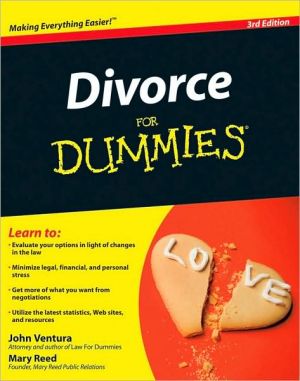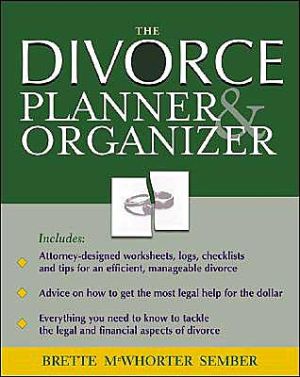Divorce For Dummies
Since Divorce For Dummies, 2nd Edition published in 2005, there have been considerable changes in collaborative divorces, common law marriages, same sex marriages, visitation, and even custody laws (from children to pets). Divorce For Dummies, 3rd Edition includes 25 percent new, revised, and refreshed material covering all of the above.
Search in google:
Now updated — your realistic, reassuring guide to surviving divorceGetting divorced is almost never easy, but this practical, plain-English guide helps you get through the proceedings with a minimum of stress and expense. It shows you the latest changes in collaborative divorces, common law and same-sex marriages, and even custody law — and how to work out the terms so you can begin building a fulfilling postdivorce life.Understand the divorce process — review the key issues and decisions, get your finances in order, and file the petitionDecide whether divorce is the best option — weigh the pros and cons of separation, consider marriage counseling, and learn about annulmentsPut things in motion — initiate the proceedings, break the news to your spouse and children, and deal with your emotionsMake important and difficult decisions — divide your assets and debts, make a case for spousal support, and get the best custody arrangement for your childrenProtect yourself — plan for life after divorce, safeguard your money, and take action if things turn unfriendly or dangerousAvoid a divorce trial — negotiate your own divorce, seek help from an attorney, and work with a mediatorHandle postdivorce challenges — meet your financial obligations, deal with visitation and child support problems, and get your personal life back on trackOpen the book and find:What to do before you file for divorceTips for finding a competent, affordable divorce attorneyHelp for managing your finances during and after divorceAdvice on helping children copeDivorce blogs, Web sites, and support groupsWays to rebuild your life after divorceHow to utilize mediation when negotiations get roughAlternatives to divorce
Divorce For Dummies\ \ By John Ventura \ John Wiley & Sons\ ISBN: 0-7645-8417-0 \ \ \ Chapter One\ Understanding What Divorce Is All About\ In This Chapter\ * Figuring out your financial future\ * Beginning the divorce process\ * Knowing the steps in the divorce process * Resolving the basic issues in your divorce\ * Figuring out the financial costs of divorce\ * Getting through your emotions\ The thought that a divorce is in your future may make your stomach churn and cause you to lie awake at night worrying about what the process will be like, especially if your only knowledge of the legal system comes from watching courtroom dramas on TV. Understandably, the prospect of dealing with lawyers, courts, and legal mumbo jumbo may intimidate you.\ Like most people in your situation, you're probably also concerned about what the divorce will do to your finances. You may worry about how much you'll have to spend to get divorced and whether after your divorce is final, you'll have to pay every penny you earn on spousal support and/or child support (or whether you'll receive enough spousal support or child support from your spouse). You may also lose sleep wondering about the kind of post-divorce lifestyle you will be able to afford.\ And, if you have young children, you probably have worries about how your divorce will affect them. You're right to be concerned because studies show that when parents don't work together to make their children feel safe and tokeep their lives as normal as possible during and after their divorce, the children are apt to suffer emotionally. Studies also show that these same children have difficulty establishing healthy relationships as adults.\ But, after you read this book, you should sleep better at night and worry a little less because you'll be armed with the information and advice you need to help you and your children get through your divorce and prepare for life afterward.\ This chapter highlights the kinds of pre-divorce planning you should do, provides you with a peak at the divorce process, explains the differences between a fault and a no-fault divorce, helps you calculate the cost of your divorce, and reviews the main money-related issues that you have to resolve in most divorces. In this chapter, we also touch on the emotional aspects of divorce. In addition, we introduce you to some of the professionals you may need to call on to help with your divorce and to the role that mediation and the collaborative law process can play in a divorce.\ Considering Whether You Have Cause for Concern\ If your marriage is going through tough times, you may find yourself wondering whether it's an example of the "for better or for worse" alluded to in your marriage vows or whether your relationship is truly on the rocks. Although no test exists that can tell you whether your problems are typical reactions to the stress and strain that most marriages experience at one time or another or whether they point to more serious issues, troubled marriages do tend to exhibit many of the same characteristics. How many of the following statements apply to your marriage?\ \ In your mind, your spouse just can't do anything right anymore.\ \ \ You fight constantly.\ \ \ You've lost the ability or the willingness to resolve your marital problems.\ \ \ Resentment and contempt have replaced patience and love.\ \ \ You've turned from lovers into roommates.\ \ \ One or both of you is having an affair.\ \ \ You go out of your way to avoid being together and, when you are together, you have nothing to talk about.\ \ \ Your children are reacting to the stress in your marriage by fighting more, having difficulty in school, getting into trouble with the police, abusing drugs or alcohol, or becoming sexually promiscuous.\ \ \ You have begun having thoughts about divorce.\ \ Don't panic if you find that your marriage exhibits some of these characteristics because you're not necessarily headed for divorce court. However, you do have cause for concern; you and your spouse need to assess your options - first separately and then together - and decide what to do next.\ TIP\ Marital problems can trigger depression, feelings of vulnerability, powerlessness, anger, and sleep disturbances, any of which can impede clear thinking and sound decision-making. A mental health professional can help you or your spouse deal with these problems so that you can move forward. If your spouse is struggling emotionally, suggest that he or she get mental health counseling, assuming that you think your spouse will be receptive to advice coming from you given the state of your marriage.\ Getting Prepared Financially for a Divorce\ Pre-divorce financial planning is essential to minimizing the cost of your divorce and increasing the likelihood that when your divorce is over, you will have a settlement agreement that meets your short- and long-term post-divorce financial needs. (We discuss how to prepare yourself emotionally in the "Surviving the Emotional Roller Coaster" section, later in this chapter, as well as in Chapter 7.) The amount and type of planning you need to do depends on how involved you have been in managing your family's financial life, whether you have a good credit history in your own name, and whether you have maintained a career outside your home during your marriage. See Chapter 3 for advice about evaluating your family's finances.\ WARNING\ If your spouse totally surprises you with plans for a divorce, pre-divorce planning may be impossible, especially if you're clueless about your family's finances. If that's the case, your divorce teaches you a painful lesson: That not being an informed and active partner in your family's financial life is risky because you're at an immediate disadvantage if your marriage ends (or if you become widowed).\ Ideally, before your divorce begins, you will have\ TIP\ \ Built a good credit history in your own name. In other words, all or most of your credit should not be joint credit - that is, credit that you share with your spouse. Without a solid credit history of your own, you will have a difficult time qualifying for credit that has affordable terms after your divorce. You may even have a difficult time qualifying for certain kinds of jobs or promotions because some employers check your credit history as part of their decision-making process. You may also have a difficult time renting a nice place to live because some landlords review their potential tenants' credit histories as part of their screening process. Finally, without good credit, you may not be able to obtain adequate insurance.\ Cleaned up your credit history if the one you built in your own name was full of negatives. To improve your credit history, make all future credit payments on time, don't go over your credit limits, and don't take on new debt. Within a matter of months, your credit history should begin to improve.\ \ \ Begun to update your job skills and/or to develop new ones if you've been a stay-at-home parent or a full-time homemaker during your marriage. In this current economy, having the right job skills is critical to being competitive in the job market. You may have to return to school to get the skills that you need.\ \ \ Considered taking a part-time or full-time job while you're married. By taking a job while you're married, you can begin adding recent work experience to your resume and begin building some professional relationships that may help you after you're out of your marriage.\ \ \ Taken a basic class in personal finance at your local college or university or through some other resource if you know next to nothing about money matters or feel that you need a refresher course. Having the right money-related information and skills is essential to negotiating the financial aspects of your divorce and to managing your money wisely when you are on your own.\ \ \ Created a written inventory of all your family's assets and assigned an approximate value to each one. Going into a divorce, having a complete record of everything you and your spouse own is important so that you know what assets you have to divide up between you. Without a record, you may overlook an asset and not get all that you're entitled to in your divorce. When compiling your list, don't worry about listing items of little value; instead, focus on financially significant assets like real estate, stocks, mutual funds and bonds, vehicles, antiques, fine art, and so on. Also, when valuing each asset on your inventory, write down its market value - what the asset is worth now, meaning what someone would pay for it if you were selling it right now. Market value isn't what you or your spouse paid for the asset when you first purchased it or what you wish the asset were worth.\ \ \ Inventoried all your family's debts. Your inventory should note the name of each creditor and how much you owe each one as well as which of your assets may secure your debts. For example, your home secures your mortgage loan. In other words, if you default on the loan, the mortgage holder is legally entitled to take back your home. Creating an inventory of all your marital debts is just as important as inventorying all your marital assets because you have to divvy up those debts during your divorce negotiations, too.\ \ \ Located all the ownership papers for your assets. These documents include deeds to property; titles to vehicles; documentation for stocks, bonds, mutual funds, and other investments that you and your spouse may own; life insurance policies; estate-planning documents that you and your spouse prepared; information about your respective retirement plans; and so on. You need these documents for two reasons. First, you need them to help determine the value of the assets that you and your spouse are dividing between yourselves. Second, after you've divided everything, you need the documents so that you can properly transfer the titles to you or your spouse, depending on who gets what. Without the title to the assets you're taking away from your marriage, you will not be their legal owner.\ \ \ Obtained copies of important documents, such as your family's tax returns for the past five years and your real estate tax bills for the most current year. Also have a record of all your bank accounts - the accounts that you and your spouse share as well as your individual accounts - including the types of accounts, the financial institutions where the accounts are located, and the account numbers.\ \ \ Have begun thinking about your post-divorce financial needs - the money and other assets you will need to live a financially secure life after your marriage ends. Consider what trade-offs you're willing to make with your spouse to ensure that your needs are met.\ \ Making It Official\ Before your divorce can begin, you must take care of some preliminary divorce matters. For example, you must make certain that you meet the divorce requirements of the state where you want to get divorced. Also, you or your divorce attorney must file legal paperwork with the court to officially set your divorce in motion and you must decide whether you will file a no-fault or fault divorce, assuming fault divorces are permitted in the state where you are divorcing.\ TIP\ If you don't want to live with your spouse anymore, but you don't want to get divorced, either, you and your spouse can separate. You can separate temporarily while you decide what to do about your relationship or you can make your separation permanent and finalize it with a legal separation agreement, which addresses the same kind of issues you would address in a divorce. We discuss the pros and cons of separation in Chapter 4.\ Meeting the requirements\ To get a divorce, you must meet certain minimum requirements set by your state. Although those requirements vary somewhat from state to state, the most common ones are\ \ Residing in your state for a certain period of time. A handful of states have no residency requirement - your obvious destination for a "quickie divorce" - but most states require that one or both of you be a resident for a minimum amount of time before you can file a petition for divorce or before your divorce can be granted. Six months is the most common residency requirement, but some states' requirements are weeks, months, or even a year. Also, some counties have their own residency requirements.\ \ \ Getting divorced in the state where you live. You must get divorced in the state you call your permanent home - and not in the state where you got married.\ \ \ Being separated. Before you can get a no-fault divorce, some states require that you live apart from your spouse for a certain period of time - six months to a year in most of these states, but as long as two to three years in some states. The theory behind this requirement is that, with enough time, you and your spouse may have a change of heart and reconcile. See Chapter 4 for information about legalizing a formal separation.\ \ You can find out the particular divorce requirements in your state in several ways. You can do an Internet search using key words like "requirements for divorce in [your state]." You can call your local family court, check with your local bar association, or contact a divorce attorney in your area. If any of these resources can't or won't provide you with the information that you're looking for, they should be able to tell you where you can get it.\ Filing a divorce petition\ No matter what state you live in and regardless of whether you and your spouse agree that ending your marriage is for the best, your divorce begins when one of you files a divorce petition with the court. If you and your spouse have already hired divorce attorneys, one of the attorneys files the divorce petition. (See the later section in this chapter, "Involving a divorce attorney," as well as Chapters 13 and 14, for more information about working with a divorce attorney.) Otherwise, one of you can go to your local courthouse and file a divorce petition yourself.\ After someone files a divorce petition, the nonfiling spouse is legally notified about the petition, which usually involves a sheriff or constable hand delivering the notice or the nonfiling spouse receiving it in the mail. The nonfiling spouse isn't served at all if he or she waives notification, which is most likely to occur if both spouses agreed to an amicable divorce and are already familiar with everything in the divorce petition. If the nonfiling spouse disagrees with anything in the petition, such as the grounds for the divorce, the request by the filing spouse for sole custody of the couple's children, and so on, he or she will file an answer with the court, stating his or her side of those issues.\ Deciding who's at fault\ Depending on the state you live in, if you initiated your divorce, you must decide whether to file a fault or a no-fault divorce. As of this writing, about 70 percent of all states allow couples to get either an old-fashioned fault divorce or a no-fault divorce, which is a kinder, gentler type of divorce.\ When you file a fault divorce, you must provide a very specific reason, or grounds, for wanting to end your marriage. In other words, you must accuse your spouse of some sort of unacceptable behavior, such as adultery, physical abuse, mental cruelty, drunkenness, drug addiction, or insanity. Depending on your state, you may also be able to get a fault divorce if your spouse has been in prison for a minimum period of time or has deserted your marriage.\ When you allege fault, you must also prove that the grounds actually exist. Proving fault can involve having a friend or relative who witnessed your spouse's bad behavior testify to it, although they may be reluctant to get involved in your divorce, especially if they like your spouse. Or you may need to hire a detective to document your spouse's bad behavior on video. Although a fault divorce can provide the grist for a lurid soap opera, some spouses feel that the drama is worth it because if they can prove that what they allege about their partner is true, they can get a better divorce settlement.\ Currently, all states recognize some form of no-fault divorce. If you opt for this kind of divorce, you don't have to prove that your spouse did anything to cause you to seek a divorce. Instead, all you really need to do is acknowledge that things "just didn't work out" between the two of you. Common grounds for obtaining a no-fault divorce include "incompatibility," "irretrievable breakdown," or "irreconcilable differences." Because you don't need to prove fault, this kind of divorce is usually less expensive, quicker to complete, and easier on spouses and their children than most fault divorces. As a result, no-fault divorces are much more frequent than fault divorces.\ (Continues...)\ \ \ \ \ Excerpted from Divorce For Dummies by John Ventura Excerpted by permission.\ All rights reserved. No part of this excerpt may be reproduced or reprinted without permission in writing from the publisher.\ Excerpts are provided by Dial-A-Book Inc. solely for the personal use of visitors to this web site. \ \
Introduction.PART I: Trouble in Paradise.Chapter 1: What to Do First When Things Start to Go Wrong.Chapter 2: Getting Smart about Your Family's Money Matters.Chapter 3: Family Law Basics.Chapter 4: Divorce Law Basics.Chapter 5: Separation: A Healthy Breather or a Prelude to Divorce?PART II: Divorce Preliminaries.Chapter 6: Putting Your Divorce in Motion.Chapter 7: Helping Your Kids Get through Your Divorce.Chapter 8: Taking Care of Your Emotional Self.PART III: Decisions, Decisions.Chapter 9: Yours, Mine, or Ours? Dividing Up What You Own.Chapter 10: Alimony: Determining When and How It's Paid.Chapter 11: Custody: Deciding in Your Children's Best Interests.Chapter 12: Child Support: Providing Your Kids with the Necessities.PART IV: Working Out the Terms of Your Divorce Agreement.Chapter 13: Doing (Some of) the Negotiating Yourself.Chapter 14: Hiring a Divorce Attorney.Chapter 15: Helping Your Attorney to Get the Best Results Possible.Chapter 16: Using Mediation to Avoid a Divorce Trial.Chapter 17: The Divorce Trial: Putting the Decisions in the Hands of a Judge.PART V: After Your Divorce Is Finalized.Chapter 18: Handling the Practical Matters of Life after Divorce.Chapter 19: The Toughest Post-Divorce Problems (And How to Solve Them).Chapter 20: Thinking Ahead: Prenuptial and Postnuptial Agreements.PART VI: The Part of Tens.Chapter 21: Ten Great Divorce Web Sites.Chapter 22: Ten Ways to Help Make Everything Okay for Your Kids.Chapter 23: Ten Tips forPutting Your Divorce behind You and Moving On.Chapter 24: Ten Strategies for Next Time to Keep Divorce at Bay.Glossary of Terms.Index.Book Registration Information.








